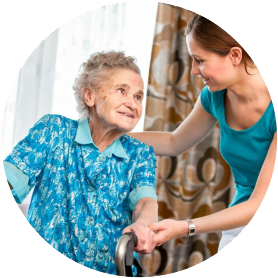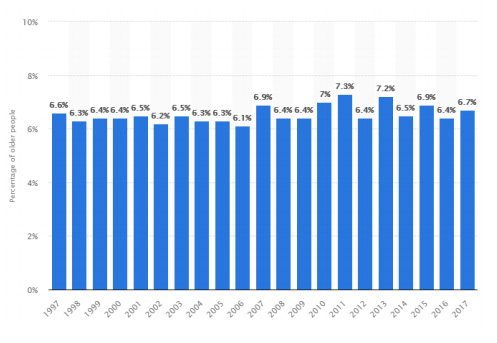Our senior population often relies on a caregiver to complete their daily tasks. There are two types of caregivers an informal caregiver and a formal caregiver. An informal caregiver is an unpaid individual involved in assisting others with activities of daily living or medical tasks. A formal caregiver is a paid care provider providing care in one’s home or in a care setting such as a daycare, residential facility, or long term care facility.
 Approximately 43.5 million caregivers have provided unpaid care to an adult or child in the last 12 months, and about 34.2 million Americans have provided unpaid care to an adult age 50 or older in the last 12 months National Alliance for Caregiving and AARP. (2015). Caregiving in the U.S.] 15.7 million of those adult family caregivers care for someone who has Alzheimer’s disease or other dementia. The value of services provided by informal caregivers has steadily increased over the last decade, with an estimated economic value of $470 billion in 2013, up from $450 billion in 2009 and $375 billion in 2007.
Approximately 43.5 million caregivers have provided unpaid care to an adult or child in the last 12 months, and about 34.2 million Americans have provided unpaid care to an adult age 50 or older in the last 12 months National Alliance for Caregiving and AARP. (2015). Caregiving in the U.S.] 15.7 million of those adult family caregivers care for someone who has Alzheimer’s disease or other dementia. The value of services provided by informal caregivers has steadily increased over the last decade, with an estimated economic value of $470 billion in 2013, up from $450 billion in 2009 and $375 billion in 2007.
Percentage of older people who needed help with personal care from other persons in the U.S. from 1997 to 2017

Caregiving tasks
- On average, caregivers spend:
- 13 days each month on tasks such as shopping, food preparation, housekeeping, laundry, transportation, and giving medication;
- 6 days per month on feeding, dressing, grooming, walking, bathing, and assistance toileting;
- 13 hours per month researching care services or information on disease, coordinating physician visits or managing financial matters. [Gallup-Healthways. (2011). Gallup-Healthways Well-Being Index.]
- Of family caregivers who provide complex chronic care:
- 46{ab00da231405656ab53e236adbc822260719de0342a41ff7a037e7d07eabcb24} perform medical and nursing tasks;
- More than 96{ab00da231405656ab53e236adbc822260719de0342a41ff7a037e7d07eabcb24} provide help with activities of daily living (ADLs) such as personal hygiene, dressing and undressing, getting in and out of bed, or instrumental activities of daily living (IADLs) such as taking prescribed medications, shopping for groceries, transportation, or using technology, or both. [AARP and United Health Hospital Fund. (2012). Home Alone: Family Caregivers Providing Complex Chronic Care.]
- On average, caregivers perform 1.7 of 6 ADLs, most commonly getting in and out of beds and chairs (43{ab00da231405656ab53e236adbc822260719de0342a41ff7a037e7d07eabcb24}). [National Alliance for Caregiving and AARP. (2015). Caregiving in the U.S.]
- On average, caregivers perform 4.2 of 7 IADLs, most commonly transportation (78{ab00da231405656ab53e236adbc822260719de0342a41ff7a037e7d07eabcb24}), grocery or other shopping (76{ab00da231405656ab53e236adbc822260719de0342a41ff7a037e7d07eabcb24}), and housework (72{ab00da231405656ab53e236adbc822260719de0342a41ff7a037e7d07eabcb24}). [National Alliance for Caregiving and AARP. (2015). Caregiving in the U.S.]
- 57{ab00da231405656ab53e236adbc822260719de0342a41ff7a037e7d07eabcb24} of caregivers report that they do not have a choice about performing clinical tasks, and that this lack of choice is self-imposed.
- 43{ab00da231405656ab53e236adbc822260719de0342a41ff7a037e7d07eabcb24} feel that these tasks are their personal responsibility because no one else can do it or because insurance will not pay for a professional caregiver.
- 12{ab00da231405656ab53e236adbc822260719de0342a41ff7a037e7d07eabcb24} report that they are pressured to perform these tasks by the care receiver.
- 8{ab00da231405656ab53e236adbc822260719de0342a41ff7a037e7d07eabcb24} report that they are pressured to perform these tasks by another family member. [AARP and United Health Hospital Fund. (2012). Home Alone: Family Caregivers Providing Complex Chronic Care.]
- Caregivers report holding significant decision-making authority regarding the following:
- Monitoring of the care recipient’s condition and adjusting care (66{ab00da231405656ab53e236adbc822260719de0342a41ff7a037e7d07eabcb24});
- Communicating with healthcare professionals on behalf of the care recipient (63{ab00da231405656ab53e236adbc822260719de0342a41ff7a037e7d07eabcb24});
- Acting as an advocate for the care recipient with care providers, community services, or government agencies (50{ab00da231405656ab53e236adbc822260719de0342a41ff7a037e7d07eabcb24}). [National Alliance for Caregiving and AARP. (2015). Caregiving in the U.S.]
Time Spent Caregiving
- 4 in 10 (40{ab00da231405656ab53e236adbc822260719de0342a41ff7a037e7d07eabcb24}) caregivers are in high-burden situations, 18{ab00da231405656ab53e236adbc822260719de0342a41ff7a037e7d07eabcb24} medium burden, and 41{ab00da231405656ab53e236adbc822260719de0342a41ff7a037e7d07eabcb24} low burden based on the Level of Care Index (1997). Burden of care increases with hours of care provided. 92{ab00da231405656ab53e236adbc822260719de0342a41ff7a037e7d07eabcb24} of providers providing 21 or more hours per week are high burden versus 16{ab00da231405656ab53e236adbc822260719de0342a41ff7a037e7d07eabcb24} of lower hour providers. [National Alliance for Caregiving and AARP. (2015). Caregiving in the U.S.]
- Primary family caregivers of people with dementia report spending an average of 9 hours per day providing help to their relatives. [Fisher, G. G., Franks, M. M., Plassman, B. L., Brown, S. L., Potter, G. G., Llewellyn, D., et al. (2011). Caring for Individuals with Dementia and Cognitive Impairment, not Dementia: Findings from the Aging, Demographics, and Memory Study.]
Hours per Week
- Family caregivers spend an average of 24.4 hours per week providing care. Nearly 1 in 4 caregivers spends 41 hours or more per week providing care. [National Alliance for Caregiving and AARP. (2015). Caregiving in the U.S.]
- Family caregivers who reside with those they provide care for spend 40.5 hours per week caring for this person.
- Those caring for a spouse/partner spend 44.6 hours per week performing
caregiving tasks. - Those caring for a child under age 18 spend 29.7 hours per week performing caregiving tasks. [National Alliance for Caregiving and AARP. (2015). Caregiving in the U.S.]
- Those caring for a spouse/partner spend 44.6 hours per week performing
- Older caregivers who are 75+ years old provide 34 hours in an average week on caregiving. Middle aged caregivers report spending 21.7 hours per week on caregiving tasks. [National Alliance for Caregiving and AARP. (2015). Caregiving in the U.S.]
- Family and other unpaid caregivers of people with Alzheimer’s disease and other dementias provide an estimated 21.9 hours of care per week. [Alzheimer’s Association. (2015). 2015 Alzheimer’s Disease Facts and Figures.]
Months and Years Providing Care
- The average duration of a caregiver’s role is 4 years.
- Only 30{ab00da231405656ab53e236adbc822260719de0342a41ff7a037e7d07eabcb24} of caregivers provide care for less than a year.
- 24{ab00da231405656ab53e236adbc822260719de0342a41ff7a037e7d07eabcb24} of caregivers provide care for more than 5 years.
- 15{ab00da231405656ab53e236adbc822260719de0342a41ff7a037e7d07eabcb24} of caregivers provide care for 10 or more years. Higher-hour caregivers are twice as likely to have been in their caregiving role for 10 years or more. [National Alliance for Caregiving and AARP. (2015). Caregiving in the U.S.]
- Regardless of employment status, unpaid caregivers report that positive activities in their respective daily lives are reduced by 27.2{ab00da231405656ab53e236adbc822260719de0342a41ff7a037e7d07eabcb24} as a result of their caregiving responsibilities. This effect is three times greater in their personal lives than in their professional lives. [Coughlin, J. (2010). Estimating the Impact of Caregiving and Employment on Well-Being: Outcomes & Insights in Health Management.]
- Measured by duration of care, Alzheimer’s and dementia caregivers provide care on average 1-4 years more than caregivers caring for someone with an illness other than Alzheimer’s disease. They are also more likely to be providing care for five years or longer. [Alzheimer’s Association. (2015). 2015 Alzheimer’s Disease Facts and Figures.]
Family Caregiver Alliance National Center on Caregiving “ Caregiver Statistics: Demographics” https://www.caregiver.org/caregiver-statistics-demographics
